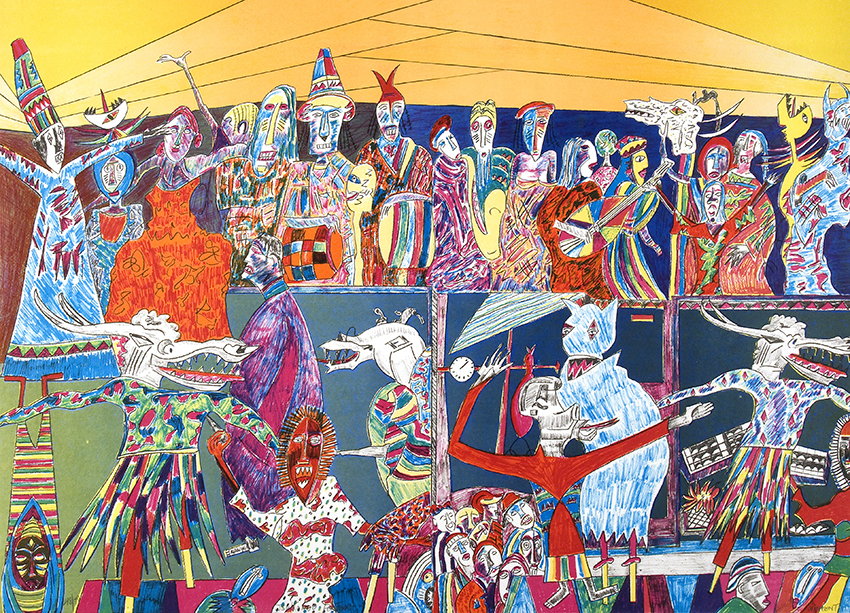Black History Month 2023: Vincent D. Smith
The art of African Americans has long been part of the American experience, beginning as enslaved Africans brought art forms, styles, and techniques to the U.S. Those artistic roots have impacted American art ever since, and African American artists are a vital and vibrant part of contemporary art in this country. The artist Vincent D. Smith, who grew up during the Harlem Renaissance (ca. 1920s–1930s), had a major impact on African American modernism in the Post-Civil Rights Movement Era.
 |
| Vincent D. Smith (1929–2004, U.S.), Jonkonnu Festival, 1996. Color lithograph on paper, 21 9/16" x 29 13/16" (54.8 x 75.7 cm). Courtesy of the Philadelphia Museum of Art. © 2023 Artist or Estate of Artist. (PMA-4228) |
Jonkonnu (or Junkanoo) is an annual carnival-like festival that dates back to colonial times, probably originating in the Caribbean and spreading to the southeastern U.S. It is usually held around Christmas, blending aspects of African and British traditions of masquerade, performance, parades, and dancing. Historically, it gave enslaved people a day off for festivities and music drawn from African origins.
Smith's depiction of Jonkonnu Festival captures the energy of African indigenous dancing in color, rhythm, and shapes. The figures are abstracted into simple shapes, much like those in the work of Jacob Lawrence (1917–2000). The print presents an animal mask procession during the festival. Animal masks have traditionally been a part of many African cultures' ceremonies and celebrations. Smith reminds the viewer of Jonkonnu's connection to African traditions with the many African-inspired masks in the foreground.
Two participants featured prominently in the foreground (on the right and left sides) wear the Kponyungo ("funeral head" or "firespitter") masks. The Kponyungo of the Senufo people of Ivory Coast were worn during funerals and other occasions by members of the Poro Society to ward off negative spiritual influences. In the context of Jonkonnu, Smith displays the Kponyungo to emphasize the African American community's connection to their ancestral lands and customs.
After the Harlem Renaissance, segregation and racial inequality resulted in a decline in patronage for African American artists in the 1940s and 1950s. The Civil Rights Movement of the 1960s galvanized Black artists to push for a revival of exhibitions and study of African American art. This led to the formation of groups dedicated to integrating common aesthetic problems with a commitment to civil rights. The group Spiral, founded in New York in 1963, elevated awareness of the dual motivations among Black artists: art that was relevant to the Black community (often narrative) and the search for individual modern expression outside of political concerns, including abstraction.
Smith was born in Brooklyn. After viewing paintings by Post-Impressionist painter Paul Cézanne (1839-1906) at the Museum of Modern Art, New York, in 1951, Smith quit his job at the U.S. postal service to become a full-time artist. He studied at the Art Students League under Social Realist Reginald Marsh (1898–1954) and took painting classes at the Brooklyn Museum school. Early paintings revealed the influence of German Expressionism, while his subject matter of Harlem nightlife showed a connection to the Harlem Renaissance. He studied painting further at the Skowhegan School in Maine. His paintings of the 1950s reflected his experiences in Brooklyn and nightlife of the Village and Lower East Side (an artists' community at the time). However, these works did not garner major recognition because of the dominance of Abstract Expressionism at the time.
In the 1960s, certainly aware of the work of Romare Bearden (1911–1988), Smith began to incorporate collage into his work, many of which broached political and social concerns. He participated in Spiral shows and exhibitions that supported the Congress of Racial Equality (CORE), a nonviolent civil rights activist organization. Like many Black artists of his generation, Smith created artworks that engaged in social issues and the culture of urban African Americans throughout his career. His work had a unique, expressive quality, while he followed the example of Lawrence by balancing social justice themes with a unique, personal modernist aesthetic.
Correlations to Davis programs: Experience Art: Chapter 7; A Community Connection 2E: 7.1; Experience Printmaking: Chapter 7; Explorations in Art 2E Grade 1: 2.9, 2.10; Explorations in Art 2E Grade 2: 5.3, 5.5; Explorations in Art 2E Grade 3: 6.6; Explorations in Art 2E Grade 4: 5.9; Explorations in Art 2E Grade 6: 6.7, 6.9

Comments